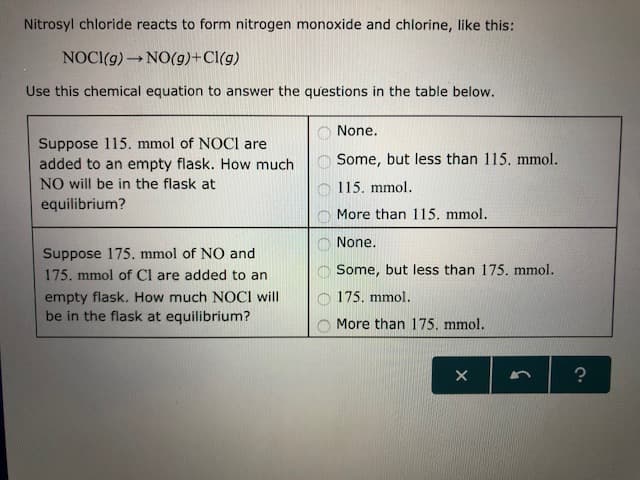Nitrosyl chloride reacts to form nitrogen monoxide and chlorine, like this: NOCI(g)NO(9)+Cl(g) Use this chemical equation to answer the questions in the table below. None. Suppose 115. mmol of NOCl are added to an empty flask. How much NO will be in the flask at equilibrium? Some, but less than 115. mmol. 115. mmol. n More than 115. mmol. nNone. O Some, but less than 175. mmol. Suppose 175. mmol of NO and 175. mmol of CI are added to an empty flask. How much NOCl wl|O 175. mmol be in the flask at equilibrium? O More than 175. mmol.
Nitrosyl chloride reacts to form nitrogen monoxide and chlorine, like this: NOCI(g)NO(9)+Cl(g) Use this chemical equation to answer the questions in the table below. None. Suppose 115. mmol of NOCl are added to an empty flask. How much NO will be in the flask at equilibrium? Some, but less than 115. mmol. 115. mmol. n More than 115. mmol. nNone. O Some, but less than 175. mmol. Suppose 175. mmol of NO and 175. mmol of CI are added to an empty flask. How much NOCl wl|O 175. mmol be in the flask at equilibrium? O More than 175. mmol.
Chemistry
10th Edition
ISBN:9781305957404
Author:Steven S. Zumdahl, Susan A. Zumdahl, Donald J. DeCoste
Publisher:Steven S. Zumdahl, Susan A. Zumdahl, Donald J. DeCoste
Chapter1: Chemical Foundations
Section: Chapter Questions
Problem 1RQ: Define and explain the differences between the following terms. a. law and theory b. theory and...
Related questions
Question
Can you please explain how to solve this problem and the answers?

Transcribed Image Text:Nitrosyl chloride reacts to form nitrogen monoxide and chlorine, like this:
NOCI(g)NO(9)+Cl(g)
Use this chemical equation to answer the questions in the table below.
None.
Suppose 115. mmol of NOCl are
added to an empty flask. How much
NO will be in the flask at
equilibrium?
Some, but less than 115. mmol.
115. mmol.
n More than 115. mmol.
nNone.
O Some, but less than 175. mmol.
Suppose 175. mmol of NO and
175. mmol of CI are added to an
empty flask. How much NOCl wl|O 175. mmol
be in the flask at equilibrium?
O More than 175. mmol.
Expert Solution
This question has been solved!
Explore an expertly crafted, step-by-step solution for a thorough understanding of key concepts.
This is a popular solution!
Trending now
This is a popular solution!
Step by step
Solved in 3 steps

Knowledge Booster
Learn more about
Need a deep-dive on the concept behind this application? Look no further. Learn more about this topic, chemistry and related others by exploring similar questions and additional content below.Recommended textbooks for you

Chemistry
Chemistry
ISBN:
9781305957404
Author:
Steven S. Zumdahl, Susan A. Zumdahl, Donald J. DeCoste
Publisher:
Cengage Learning

Chemistry
Chemistry
ISBN:
9781259911156
Author:
Raymond Chang Dr., Jason Overby Professor
Publisher:
McGraw-Hill Education

Principles of Instrumental Analysis
Chemistry
ISBN:
9781305577213
Author:
Douglas A. Skoog, F. James Holler, Stanley R. Crouch
Publisher:
Cengage Learning

Chemistry
Chemistry
ISBN:
9781305957404
Author:
Steven S. Zumdahl, Susan A. Zumdahl, Donald J. DeCoste
Publisher:
Cengage Learning

Chemistry
Chemistry
ISBN:
9781259911156
Author:
Raymond Chang Dr., Jason Overby Professor
Publisher:
McGraw-Hill Education

Principles of Instrumental Analysis
Chemistry
ISBN:
9781305577213
Author:
Douglas A. Skoog, F. James Holler, Stanley R. Crouch
Publisher:
Cengage Learning

Organic Chemistry
Chemistry
ISBN:
9780078021558
Author:
Janice Gorzynski Smith Dr.
Publisher:
McGraw-Hill Education

Chemistry: Principles and Reactions
Chemistry
ISBN:
9781305079373
Author:
William L. Masterton, Cecile N. Hurley
Publisher:
Cengage Learning

Elementary Principles of Chemical Processes, Bind…
Chemistry
ISBN:
9781118431221
Author:
Richard M. Felder, Ronald W. Rousseau, Lisa G. Bullard
Publisher:
WILEY